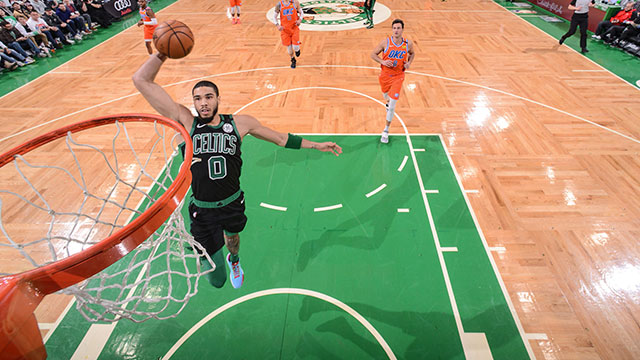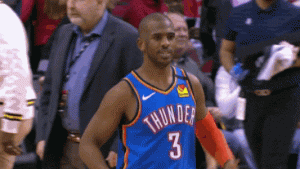NBA Restart: Boston Celtics 2020 Playoff Squad

Jayson Tatum dunks on the Oklahoma City Thunder. Photo courtesy of NBA.
Written by Brandon C. Kesselly (@bckesso)
It’s almost playoff time, y’all. You know what that means! It’s rotation time, and I ain’t talking about the 8 Trigrams. My favorite basketball team, the Boston Celtics, will most likely be entering the 2020 NBA Playoffs as the #3 seed in the Eastern Conference. As we all know, playoff teams typically rely on smaller rotations and place a heavier emphasis on the players’ abilities. What will be the key lineups to the Celtics’ success? Who will step up to the plate?
First let’s examine the players, and then we’ll see how they’ve worked together. Note: All figures are pre-restart stats, ignoring the scrimmages.
Starters
#8 Kemba Walker (G)
PPG: 21.2 RPG: 4.1 APG: 4.9 PER: 20.29
Coming off a long tenure with the Charlotte Hornets, All-Star guard Kemba Walker is the veteran leader of the team. He’s second in team scoring while he leads in assists, made free throws, and made 3-pointers. While somewhat untested in the NBA Playoffs, Walker’s clutch performances and collaborative mentality throughout the season make him a greater asset than a liability. Walker has missed a lot more games this season than in his entire career, so his playing time and motor may be affected by his ongoing knee troubles. Still, the Celtics will need his shooting if they want to have any legitimate chance at a deep run.
#7 Jaylen Brown (G/F)
PPG: 20.4 RPG: 6.4 APG: 2.2 PER: 17.15
Jaylen Brown is a much better player than I often give him credit for. In his fourth year, he is third in overall scoring but second in made field goals, with a magnificent 49.0%. While he was arguably snubbed for his first All-Star appearance this year, his athleticism, defense, and scoring have made him a force to be reckoned with since his freshman season. Brown’s defense hasn’t been his best quality this season, but he is still a good enough defender to help his team to victory.
#0 Jayson Tatum (F/G)
PPG: 23.6 RPG: 7.1 APG: 2.9 PER: 20.41
Speaking of All-Stars, Jayson Tatum has been on a roll in only his 3rd season. In the wake of the mass exodus of talent this past offseason, the young Duke product has blossomed into the primary scoring option for the Celtics despite the arrival of Kemba Walker, famously averaging 28.2 points over the last 20 games before the COVID-19 stoppage of play. On top of his buckets, Tatum ranks second on the team in rebounds per game and is shooting 39.8% from deep. He also gets to the line, knocks down 80.6% of his free throws, and was February’s Eastern Conference Player of the Month.
PPG: 17.3 RPG: 6.5 APG: 4.1 PER: 18.25
Gordon Hayward has seemingly finally recovered from his season-ending injury two years ago. Despite scoring under 20 points per game, he’s shooting 50.2% from the field (39.2% from deep), ranks second in defensive rebounding, and ranks third in assists. Hayward’s impact on the game has been tremendous, and he will likely be critical to the Celtics’ game planning.
#27 Daniel Theis (F/C)
PPG: 9.3 RPG: 6.6 APG: 1.6 PER: 18.19
Daniel Theis is the starting center for the Celtics for a reason. He’s leading the team in blocks, ranks third in rebounding, and is averaging nearly 10 points per game. He’s also shooting 56.5% from the field. Per ESPN, Theis is one of the top centers in the league with a 3.3 RPM (#4 for all centers pre-restart), meaning he’ll be key to Boston’s defense.
Bench
#11 Enes Kanter (C)
PPG: 8.2 RPG: 7.7 APG: 1.0 PER: 22.02
Enes Kanter has truly made himself at home in Boston. After a tumultuous time in New York, and a deep playoff run in Portland, he wound up on a two-year deal with the Celtics, including hosting his own show. Since then, he’s become a go-to inside scorer and rebounder, leading the team (and, to an extent, the league) in the latter category. He’s been injured a few times this season, but is looking plenty healthy in the bubble.
#36 Marcus Smart (G)
PPG: 13.5 RPG: 3.8 APG: 4.8 PER: 14.05
Obligatory “Marcus Smart for DPOY!” In all seriousness, however, Marcus Smart is a solid ball handler, facilitator, and an All-NBA defensive player. He leads the Celtics in steals with 1.6 per game, ranks third in made three-point shots, and second in assists. He also shoots a respectable 34.8% from deep. While he is not a high scorer, he still averages in double digits and constantly makes winning plays both defensively and with his assists.
PPG: 6.6 RPG: 2.0 APG: 2.5 PER: 11.82
Brad Wanamaker is exactly the kind of backup PG you’d want on a team. He’s capable of leading the second unit, gets to the free throw line (where he leads the league with a 93.1 FT%), and knocks down at least 36.7% of his three-point shots. While he doesn’t add enough to the game to warrant more than an emergency reserve, I see him getting slightly more minutes this postseason mainly because of Walker’s knee issues.
PPG: 3.5 RPG: 2.7 APG: 1.0 PER: 8.06
As is head coach Brad Stevens’ tradition, rookie Grant Williams has seen a lot of playing time this past season, racking up 970 minutes through 62 games pre-restart. Cleaning The Glass, which filters out “garbage time” and heaved possessions, Williams gave the Celtics a +8.6 point differential per 100 possessions when inserted in the lineup (through 1,867 possessions), meaning his size and defense have been important this season. He also shoots 72.5% from the line, but he averages only 2.5 attempts per game. Still, he will be a good role player in the postseason.
#37 Semi Ojeleye (F)
PPG: 3.1 RPG: 2.0 APG: 0.5 PER: 7.64
Semi Ojeleye is one of those players whose impact is difficult to demonstrate on paper. He’s a solid defender and rebounder, but not much of a scorer. You don’t want the ball in his hands, but send him out to guard a tough forward like Giannis Antetokounmpo or Anthony Davis, and allow him to help out with offensive rebounding. He plays extremely well with Walker, Brown, Tatum, and Theis, granting them a +12 point differential when he’s in that specific lineup. With 23 playoff games under his belt, the third-year Celtic will help with defense and big man support, but he won’t be dropping buckets.
Wild Card
#44 Robert Williams III (C/F)
PPG: 4.3 RPG: 4.7 APG: 1.0 PER: 19.63
Time Lord has had his fair share of injuries, contributing to him only playing 55 games since his debut last season. He’s an extremely athletic player, impacting the defense well enough to warrant some playing time. However, even after the end of the restart, he will have played less than 500 minutes this season. While I like what he’s capable of bringing to the table, he will likely not see much playing time unless he’s very good in the restart.
Proven Lineups
Rotations are extremely important in the playoffs. But which ones have proven most effective? Here’s my lineup breakdown, using stats from NBA.com, Basketball Reference, and Cleaning The Glass. These lineups have played a minimum of 100 possessions.
Offense: Walker, Brown, Hayward, Tatum, Theis
OFF: 121.1 DEF: 108.5 AST%: 62.0 REB%: 47.7 PACE: 101.12
If it ain’t broke, don’t fix it! The starting lineup gives the C’s their most reliable offense and a reasonable pace. Four of their starting five players are averaging double digits, with three attaining 20+ points per game. This offense ranks 6th in the league, based on the aforementioned criteria. Per Cleaning The Glass, this lineup scores 122.3 points per 100 possessions and has a 61.1% eFG%.
Defense: Walker, Smart, Hayward, Tatum, Theis
OFF: 108.5 DEF: 95.5 AST%: 59.9 REB%: 51.7 PACE: 101.27
Defense wins games, y’all. Just ask Bill Belichick or even Peyton Manning. Stevens has recognized this as well, producing a top-5 defensive team this year. This was achieved in large part due to this lineup, which includes All-NBA defender Smart and walking block party Theis on top of the long-armed Tatum. Fun fact: out of all lineups that have played at least 100 minutes, this lineup ranks 5th defensively in the entire league, averaging 2.6 steals and 1.6 blocks per game. Even more impressive, however, is the fact that this lineup holds opponents to under 100 points while still scoring above that threshold.
Free Throws: Smart, Brown, Hayward, Tatum, Theis
OFF: 105.6 DEF: 103.8 AST%: 58.7 REB%: 53.1 PACE: 102.15
With the slew of rotations that have been attempted this season, this is the quickest offense the Celtics have to offer that has consistently worked for them. It also grants them more free throw attempts, with 25.9 per 48 minutes. However, it seriously gives up on defense, which could make games too close for comfort if used at the wrong time. Luckily for them, Stevens is a master of time management.
Experimental Lineups
Sometimes you have to change your lineup a bit. It can be situational, or it may be born out of necessity. Which lineups are we likely to see if the need arises? These lineups have played more than 15 possessions, but less than 100.
Pinch: Walker, Smart, Brown, Tatum, Kanter
OFF: 112.9 DEF: 97.6 AST%: 60.0 REB%: 54.7 PACE: 102.52
Sometimes you need a lineup that gives you the opportunity to come back against opponents. Your scorers need to shine, but you also need defense. This lineup, which weirdly includes Kanter, can help the Celtics recover from deficits by giving them tons of offensive rebounding and scoring versatility. Kanter is the best rebounder on the team, and Smart is one of their top defenders, while both also add scoring to the game. Cleaning The Glass gives a better picture of this lineup’s potential, with a +21.0 point differential (118.5 ORtg, 97.5 DRtg) per 100 possessions, albeit with 81 possessions played. Perhaps this lineup will get more time during the restart, allowing us to paint a more complete picture.
Small Ball: Walker, Smart, Hayward, Brown, Tatum
OFF: 112.5 DEF: 113.3 AST%: 42.9 REB%: 47.8 PACE: 99.52
This is the lineup everyone has been curious about since the start of the season. Will the Celtics’ small ball lineup work for them at all? What happens when you throw out your best offensive players together? For the C’s so far, it means you get outscored and out-rebounded. However, you also get those players to the free throw line a lot. High risk, high reward? Cleaning The Glass takes a more optimistic look at this lineup, giving them a +2.5 point differential. But they’ve only played 32 possessions (only 15 minutes!) total, and the team has only won twice when this lineup was utilized — against the Toronto Raptors in October and the Oklahoma City Thunder in February. This is a desperate lineup, and one that is still unproven. But desperate times call for desperate measures. Let’s see what happens.
Given the lack of reliable rotations this season, partially due to injuries, I don’t have a frame of reference for what lineups could work. Kanter has been out, but will see playing time based on his performances both during the season and during last year’s playoffs in Portland. Walker has also been out, but is too important to keep on the bench for too long. It would be nice to see either of the Williamses more, but they may be situational. Wanamaker might get minutes, or he might be in the same boat. But with the current squad, this team is likely to repeat their 2018 performance, making it to the Eastern Conference Finals before being bounced. Who knows, though? Maybe I’m wrong — for better or worse.
Want to keep up with PubSquare Media? Follow us on Facebook, Twitter, and Instagram!



